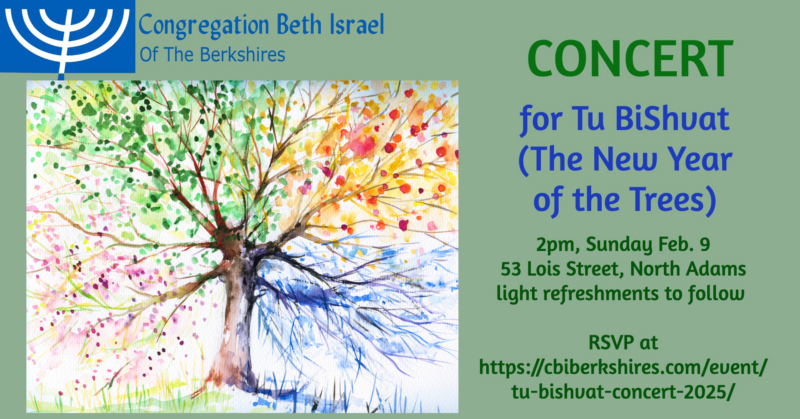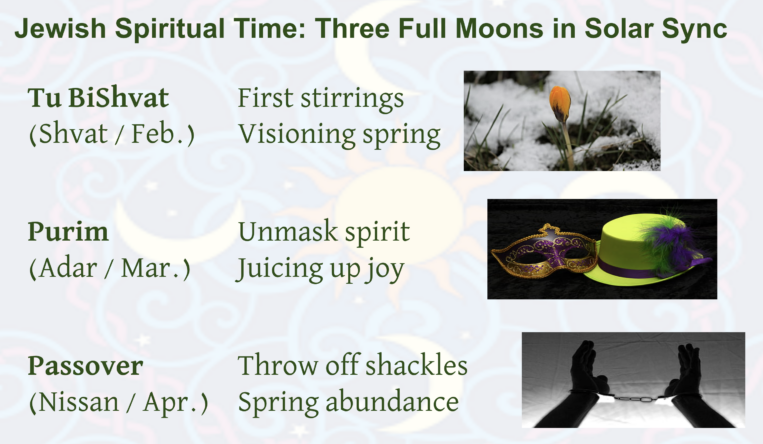Dear Congregation Beth Israel members and friends,
In the place where our traditions began, the almond trees are blooming. It’s the lunar month of Shvat, and at the full moon on the 15th of this month we celebrate Tu BiShvat, “the New Year of the Trees.” In Temple times this was something like Tax Day. Once fruit trees reached a certain age, their proceeds could be tithed to the Temple. But how do we know the exact age of a tree? Any fruit tree planted in the last year was considered to have a birthday on this day.
For our medieval mystics, living long after the fall of the second Temple, the day became something deeper. They evolved the custom of a Tu BiShvat seder that moves through the four seasons. Each season became associated with a different “world” (physical, emotional, mental, and spiritual), and each was represented with a different kind of tree nut or fruit. During a Tu BiShvat seder, through blessing and eating tree fruits, we journey around the seasons.

At CBI this year we’re celebrating Tu BiShvat with a concert that moves through the four seasons in turn, featuring the CBI choir and community musicians. From Naomi Shemer’s “Peirot Hamisha Asar” (“Fruits of the 15th / Snow on My Town”), to Brad Nix’s “A Prayer in Spring,” to the medieval “Sumer is Icumen In,” to “Rejoice / Fragile,” the premiere of a new Adam Green setting of two of my Sukkot poems, we’ll journey through the seasons in song.
Afterwards we’ll enjoy a spread of symbolic tree fruits and nuts, as we would do at a Tu BiShvat seder. Some have a shell or peel (representing Winter and the physical world), some have a pit (representing Spring and the emotional world), and some that are soft all the way through (representing Summer and the intellectual world). Representing Fall (and the world of Spirit, the harvest and culmination of the year), we’ll offer sips of maple syrup or etrogcello.
At a traditional Tu BiShvat seder we remind ourselves of the beauty of nature and our responsibility to protect it. We eat tree fruits with intention and blessing, seeking to repair our relationship with eating, with trees, and with the world around us. I hope that our concert will open our hearts to the beauty of the natural world. And as we re-live the four seasons in song, hopefully we’ll re-experience the sweetest aspects of every season in the wheel of the year.
Even if you’ve never celebrated Tu BiShvat, I hope you’ll come to our concert. Members of our community have been hard at work learning new music for the last few months, and we are excited to bring that music to you! Tu BiShvat is the beginning of spiritual spring: the time when, according to tradition, the sap begins to rise to feed the harvest of the coming year. What sap is rising in us as the days begin to lengthen? What spiritual harvest do we want to grow this year?

Tu BiShvat falls at full moon. One month later at full moon we reach Purim. And one month after that, again as the full moon shines, we’ll celebrate Pesach. These three full moons are our spiritual stepping stones from winter to spring, from constriction to liberation. So Tu BiShvat is also a good time to think about ways in which we might sometimes feel hopeless or trapped… and remember that we have emerged from Pharaoh’s cruelty before, and we can again.
Join us at 2pm on Sunday, February 9 for a feast of music to delight the ears and stir the soul. And even if clumps of snow are still adorning our trees here at this time of year, we can take comfort in knowing that in the natural course of time flowering trees will come.
Blessings to all,
— Rabbi Rachel





